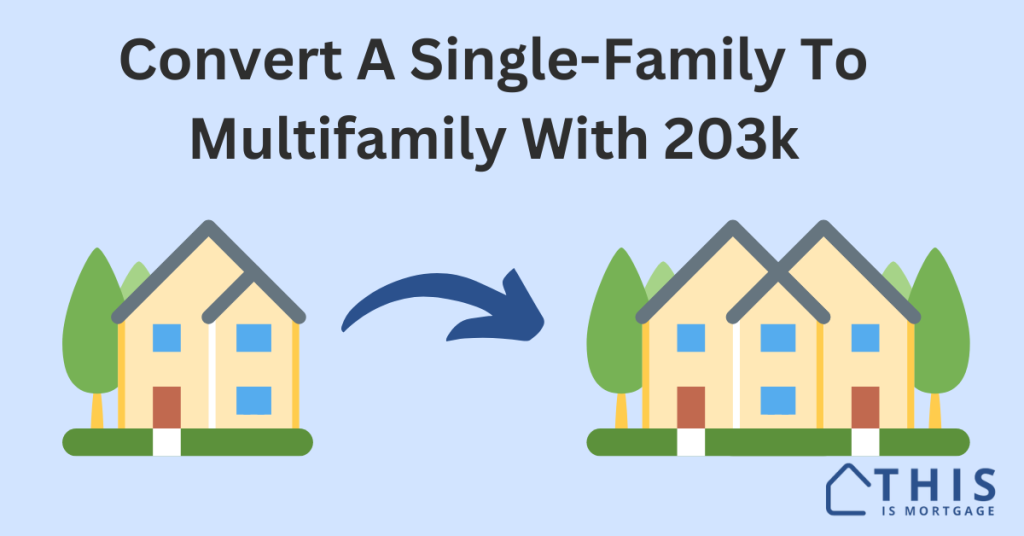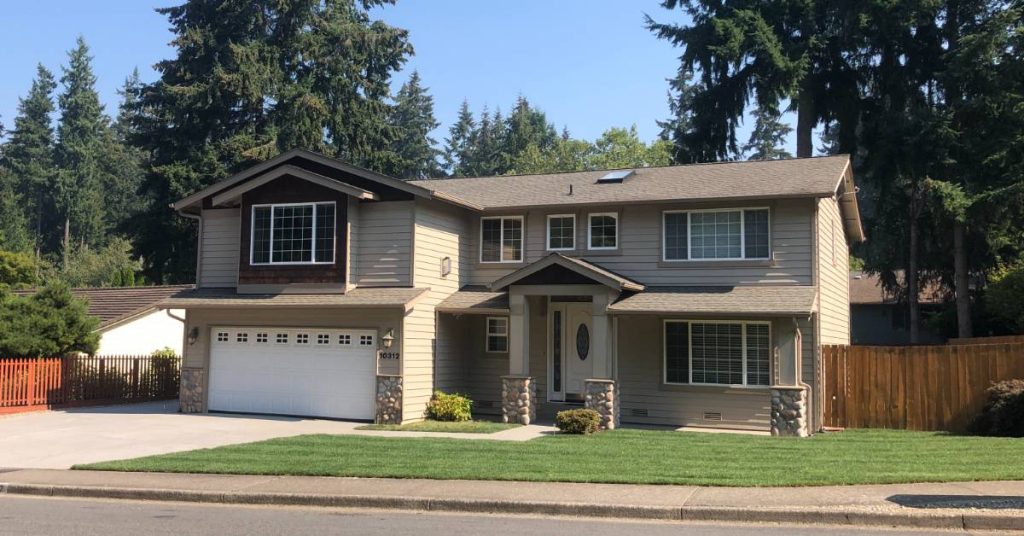FHA buyers who have looked for a duplex, triplex, or fourplex lately have probably found out that competition is fierce for these homes.
If you do find one for sale, you’ll probably have to go head-to-head with cash buyers and investors using conventional loans.
But what if you could buy a single-family home and convert it to a 2-, 3-, or 4-unit home with the FHA 203k rehab loan?
FHA guidelines say you can do just that.
Submit your single family to multifamily conversion scenario to a lender.
Can 203k convert a single-family to multifamily?
HUD guidelines state that a 203k can be used for “converting a one-family structure to a two-, three- or four-family structure.”
So, yes, you can use a 203k loan to convert a 1-unit home into a property with up to 4 units.
The 203k program allows you to finance the purchase price plus the cost of improvements, putting just 3.5% down upfront for the entire price tag. There’s likely no better way to convert a single-family home to a multifamily, increasing its income potential.
In this article, we won’t go deep into the 203k process because there are plenty of places to learn about that. Rather, we’ll touch on some of the “gotchas” that might arise when performing a single-family to multifamily conversion.
Start your 203k loan by contacting a lender.
Should you use the Limited or Standard 203k?
You will need to use the Standard 203k for two reasons. First, the construction will cost more than the $35,000 Limited 203k limit. Second, you can’t do anything structural with the Limited program.
What can you do with a Standard 203k?
You have a lot of options with the Standard or “Full” 203k.
- Room additions
- Convert basements and attics to living space
- Add a second story onto a home
- Remodeling for safety and cosmetic issues
Here’s a more complete list of eligible and ineligible repairs.
Fix cosmetic and safety issues while converting units
The appraiser will create a full list of deficiencies that could keep the home from qualifying for FHA financing. The lender will require these repairs, so budget accordingly.
While you’re at it, you might as well remodel the whole property. You don’t want to finish the project just to discover that some parts of the home are outdated.
See if you are eligible for a 203k loan.
Make sure the extra units add to the property’s value
In some markets, a duplex isn’t worth any more than a single-family residence. This can be a problem with 203k since the purchase price plus all repairs can’t exceed 110% of the future appraised value.
For example:
| SFR purchase price | $300,000 |
| Rehab + adding units | $75,000 |
| Total | $375,000 |
| Final appraised value | $335,000 |
| Cost vs value | 112% |
| Result | Ineligible for 203k (max 110%) |
Do some work upfront before ordering the appraisal and getting a bid. Make sure the property’s value will skyrocket.
You can convert basement or attic space to additional units
Think about unused space in the home. You can convert an unfinished basement or attic space into additional units. This will reduce costs since you are not building a new addition.
Speak to a lender to start your 203k loan.
You can add an ADU or non-attached addition
New rules introduced in 2023 state that you can use 203k funds to add an accessory dwelling unit (ADU) to a property. You can even use 50% of projected rental income from the yet-to-be-built ADU to qualify for the loan.
Think about separate utility metering
Get each unit in a multifamily building on its own water, electricity, and gas metering.
After all, you don’t want to be paying for your tenant’s ridiculously long showers. It’s hard to get someone to conserve water or energy when they’re not directly paying for it.
Get the permits
Do your due diligence. If local zoning only allows one-unit homes, the deal is sunk. Ensure you can get permits from your local housing authority for your desired number of units.
Look for run-down single-family homes with low demand
The benefit of converting a single-family to a multifamily in the first place is to find a property with lower demand.
There are many single-family homes on the market that won’t meet financing requirements. This isn’t a problem for you. The 203k can take care of those issues.
You can acquire a beat-up property for below asking price and get that much more value when you rehab. There’s not much use getting a turn-key house just to start tearing it apart to add units.
Connect with a lender to start your single-family to multifamily conversion.
Look for properties with massive square footage
You might be looking at a 2,500-square-foot home with another 2,500 square feet of unfinished basement. This sounds like a perfect candidate to turn into four 1,250-square-foot units.
Consider homes with huge current or potential square footage. Your plan probably won’t work out buying a 1,500-square-foot home with no room to divide. You could add an addition or a second story, but the construction price tag will be higher.
Run the self-sufficiency test for 3 & 4 unit conversions
FHA requires a 3- or 4-unit property to be able to “pay for itself” in potential rental income.
If market rents won’t cover the entire future payment, the loan won’t be approved.
Run some numbers with this FHA Self-Sufficiency Calculator to make sure the property will qualify once it’s a triplex or fourplex.
Think about how each unit will suit a future tenant’s needs
Each unit should “feel” like a typical apartment. It should have its own kitchen, dining area, bedrooms, at least one bathroom, and separate entrance. Units without all these features may not be rentable, and may not be considered as extra units by the FHA appraiser.
Also ensure there will be enough parking.
You may need to hire an architect to plan out your conversion to ensure maximum utility from each unit.
Find an experienced contractor and consultant
The contractor can mean the difference between a successful project and a terrible experience.
You should use a contractor who has done multiple 203k projects. The contractor is responsible for working up a detailed bid that is accurate down to the penny all before the work starts. Changes in bids during the loan process can lead to re-underwrites, loan amount changes, and appraisal change fees.
The contractor must request draws to get paid as milestones are completed.
Rather than training a contractor how to do a 203k, find one that already knows. Ask around local real estate investment groups on Facebook and BiggerPockets.
You will also need a 203k consultant. These are HUD-approved professionals that guide you through the process and are required for large projects. Search our list of 203k consultants.
Related reading
- How To Get a 203k On A Multifamily Home
- Buy a Duplex, Triplex, or Fourplex with FHA
- Multifamily vs Single Family Calculator
- Qualifying With Future Rental Income
FAQ
Yes. Make sure total costs will be less than 110% of the future value, that it will pass the self-sufficiency test, and that local zoning allows multiple units.
Yes, as long as 51% of the property is for residential use. You may not use 203k funds to improve non-residential space. Learn more here.
Join local real estate groups and search forums. Choose a lender that does these loans often, since there are lots of moving parts to these loans. You can also search our list of 203k lenders in every state.
It can be challenging because there are many parts to manage. From the loan requirements to finding a contractor to getting permits, it is a complex process. However, finding an experienced lender, architect, 203k consultant, and contractor can help the process go smoothly.
A seller who wants to sell the home will accept an offer with 203k financing. The repairs happen after closing, so the seller does not have to wait until construction is complete to get their sale proceeds. However, closing the loan could take 60 days or more instead of the typical 30 days for a standard FHA loan. The seller may not accept the offer if they have conventional or cash offers in hand.
The loan can be up to 96.5% of the purchase price plus renovation costs. However, you must be able to qualify for the loan and it must be within local multifamily loan limits. The total cost of the home plus improvements can’t exceed 110% of the future value.
Yes. Just like a standard FHA loan, you can get gift funds from relatives or documented close friends for the down payment and closing costs.
See if you’re eligible to convert a single-family to a multifamily
If your goal is to pick up a looked-over single-family home and convert it to a multifamily property, 203k could be your loan of choice.
Run your scenario by an experienced lender and get a pre-approval. You’ll get started on your project sooner than you thought possible.




